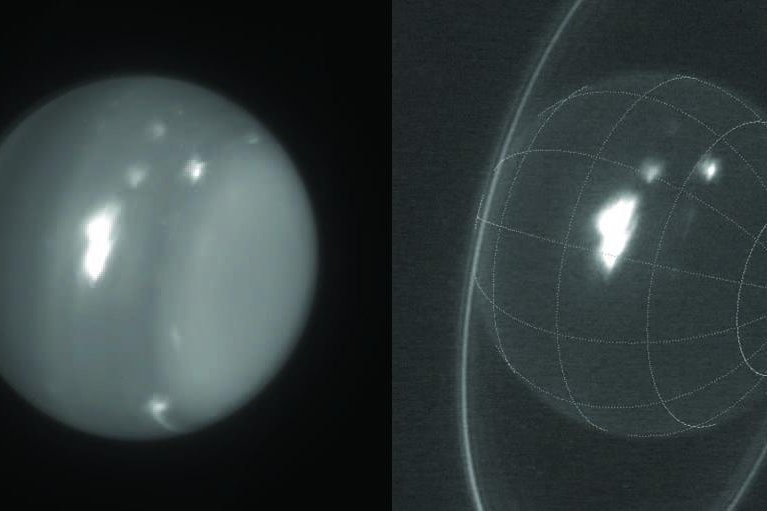You mean:
THE PHILAE LANDER HAS LANDED ON THE COMET 67P/CHURYUMOV-GERASIMENKO PEOPLE!
THE PHILAE LANDER HAS LANDED ON THE COMET 67P/CHURYUMOV-GERASIMENKO PEOPLE!
Because sometimes even national leaders just want to hang out
https://forum.nationstates.net/
The Solar System Scope wrote:You mean:
THE PHILAE LANDER HAS LANDED ON THE COMET 67P/CHURYUMOV-GERASIMENKO PEOPLE!
United Press International wrote:Cool blue Uranus currently hosting mega storms
By Brooks Hays | Nov. 13, 2014 at 12:30 PM
BERKELEY, Calif., Nov. 13 (UPI) -- Normally, the smooth blue surface of Uranus denotes a soothing, deep-space serenity. Being the seventh planet from the sun, its temperatures are cool -- it's a so-called ice giant -- and its main chemical components (hydrogen, helium, water, ammonia and methane) all play nicely with each other.
But recently, astronomers have noticed several high-powered storms swirling across the planet's surface, befuddling onlookers accustomed to an uninterrupted sphere of pale, greenish-blue. According to imagery collected by Hawaii's Keck Observatory, as well as the Hubble Telescope, Uranus currently features eight distinct storms. One of them is the largest astronomers have ever seen on the planet.

UC Berkeley/Keck Observatory wrote:Infrared images of Uranus (1.6 and 2.2 microns) obtained on Aug. 6, 2014, with adaptive optics on the 10-meter Keck telescope. The white spot is an extremely large storm that was brighter than any feature ever recorded on the planet in the 2.2-micron band. The cloud rotating into view at the lower-right limb grew into the large storm that was seen by amateur astronomers at visible wavelengths. Imke de Pater (UC Berkeley) & Keck Observatory images.

Northwest Slobovia wrote:United Press International wrote:Cool blue Uranus currently hosting mega storms
By Brooks Hays | Nov. 13, 2014 at 12:30 PM
BERKELEY, Calif., Nov. 13 (UPI) -- Normally, the smooth blue surface of Uranus denotes a soothing, deep-space serenity. Being the seventh planet from the sun, its temperatures are cool -- it's a so-called ice giant -- and its main chemical components (hydrogen, helium, water, ammonia and methane) all play nicely with each other.
But recently, astronomers have noticed several high-powered storms swirling across the planet's surface, befuddling onlookers accustomed to an uninterrupted sphere of pale, greenish-blue. According to imagery collected by Hawaii's Keck Observatory, as well as the Hubble Telescope, Uranus currently features eight distinct storms. One of them is the largest astronomers have ever seen on the planet.UC Berkeley/Keck Observatory wrote:Infrared images of Uranus (1.6 and 2.2 microns) obtained on Aug. 6, 2014, with adaptive optics on the 10-meter Keck telescope. The white spot is an extremely large storm that was brighter than any feature ever recorded on the planet in the 2.2-micron band. The cloud rotating into view at the lower-right limb grew into the large storm that was seen by amateur astronomers at visible wavelengths. Imke de Pater (UC Berkeley) & Keck Observatory images.
Article from: http://www.upi.com/Science_News/2014/11/13/Cool-blue-Uranus-currently-hosting-mega-storms/1371415896229/
The article itself is based on Amateur, professional astronomers alike thrilled by extreme storms on Uranus, which has bigger pictures, more explanation, and a low-resolution video of the storms. The caption for the pictures is from there too.
And you all were fixated on some tiny clump of ice and dirt in the inner solar system...
Northwest Slobovia wrote:The caption for the pictures is from there too.
Wisconsin9 wrote:Northwest Slobovia wrote:
(Image)
Article from: http://www.upi.com/Science_News/2014/11/13/Cool-blue-Uranus-currently-hosting-mega-storms/1371415896229/
The article itself is based on Amateur, professional astronomers alike thrilled by extreme storms on Uranus, which has bigger pictures, more explanation, and a low-resolution video of the storms. The caption for the pictures is from there too.
And you all were fixated on some tiny clump of ice and dirt in the inner solar system...
Not me. I'm too busy focusing on cosmic rays. I'm part of a team in my school's rocket club that's sending up a muon detector.



Brickistan wrote:Sadly, it seems that Philae has been lost.
Northwest Slobovia wrote:NASA releases a newly cleaned-up picture of Europa:
(Image)
More information and larger image.

Risottia wrote:Brickistan wrote:Sadly, it seems that Philae has been lost.
Not lost. Merely without power.
http://en.wikipedia.org/wiki/Philae_%28 ... eawakening
http://www.esa.int/Our_Activities/Space ... ibernation
Northwest Slobovia wrote:Wisconsin9 wrote:Not me. I'm too busy focusing on cosmic rays. I'm part of a team in my school's rocket club that's sending up a muon detector.
So maybe you could post about that, huh?
When you say "sending up" you mean what...? A balloon? A sounding rocket? A cubesat? A multi-billion-dollar gamma-ray observatory?
Wisconsin9 wrote:Northwest Slobovia wrote:So maybe you could post about that, huh?
When you say "sending up" you mean what...? A balloon? A sounding rocket? A cubesat? A multi-billion-dollar gamma-ray observatory?
Jeez, sorry I didn't answer this sooner. Thread kind of dropped off of my radar. The closest thing on your list to reality would be a sounding rocket, but we're only planning to go maybe eight klicks up.
Berdanvia wrote:Fun Fact: Russia is Bigger than Pluto.
Brickistan wrote:Philae comming out of hibernation and starting to transmitting data is good news indeed.
